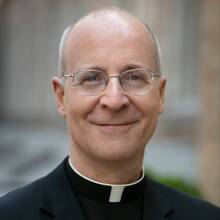 Who better than Eamon Duffy to review John Cornwell's new book on Blessed John Henry Newman, Newman's Unquiet Grave? (The title refers to the beatified cardinal's exhumation from the grave that he shared with Fr. Ambrose St. John). No one can beat Duffy for clarity of writing about the English church (or any church, for that matter). It's one of those wonderful New York Review articles that uses the book in question as a jumping-off point for a much fuller discussion of the topic. Here's part of Duffy's aptly named, "A Hero of the Church."
Who better than Eamon Duffy to review John Cornwell's new book on Blessed John Henry Newman, Newman's Unquiet Grave? (The title refers to the beatified cardinal's exhumation from the grave that he shared with Fr. Ambrose St. John). No one can beat Duffy for clarity of writing about the English church (or any church, for that matter). It's one of those wonderful New York Review articles that uses the book in question as a jumping-off point for a much fuller discussion of the topic. Here's part of Duffy's aptly named, "A Hero of the Church."
Both Newman’s attraction to Catholicism and his hesitation in embracing it sprang from a radical historicism. As an Anglican, he had subscribed to the notion that truth was unchanging. Christianity was a revealed religion, its doctrines descended to the present in an unbroken tradition from the Apostles. Nothing could count as Christian truth, unless the primitive Church had believed and taught it. The modern Church of Rome, therefore, could not claim to be the true Church, since so much about it—its elaborate worship, the dominant place of the Virgin Mary in its piety, the overweening authority of the pope—seemed alien or absent from the earliest Christianity: there were no rosary beads in third-century Carthage. Yet Newman’s reading in early Christian sources convinced him that to condemn Rome on these grounds would also be to outlaw much of the rest of mainstream Christianity. The doctrines of Incarnation and Trinity, accepted as fundamental by both Catholics and Protestants, were not to be found in their mature form in the early Church. If the central tenets of the faith could develop legitimately beyond their New Testament foundations, why not everything else?
To resolve this apparent contradiction between a religion of objectively revealed truth and the flux of Christian doctrines and practices, Newman wrote at Littlemore a theological masterpiece, the Essay on the Development of Christian Doctrine (1845). Its central claim is that the concepts and intuitions that shape human history are dynamic, not inert. Great ideas interact with changing times and cultures, retaining their distinctive thrust and direction, yet adapting so as to preserve and develop that energy in different circumstances. Truth is a plant, evolving from a seed into the mature tree, not a baton passed unchanging from hand to hand. Ideas must unfold in the historical process before we can appropriate all that they contain. So beliefs evolve, but they do so to preserve their essence in the flux of history: they change, that is, in order to remain the same. “In a higher world it is otherwise; but here below to live is to change, and to be perfect is to have changed often.”
Other nineteenth-century thinkers had anticipated aspects of this dynamic understanding of religious truth. But no one confronted its difficulties or explored its implications as fully as Newman, whose book offered a remarkable series of diagnostic tests by which to distinguish legitimate developments from corruptions of the truth. Not everything in his analysis has been found convincing, but theEssay was a landmark, legitimizing the notion of doctrinal development. Over the next century or so, it was to prove seminal for Catholic theology, as the Church increasingly sought to come to terms with its own historical contingency.
James Martin, SJ








Still, I have to protest against yet another political narrative of Newman as a ''liberal Catholic,'' a story told in response to the equally inadequate ''conservative Catholic'' account. Newman is as timeless as he was timely precisely because he transcended the limitations of both Manning and Ward on the right, and Acton and Dollinger on the left, not because he stood devotedly against one side or the other. This is precisely the upshot of his grasp of history: taking the long view, he was able to see that the problems of his age would likely not be resolved in his own day, by political or any other means. So he prudently maintained the faith, counselled those he could, wrote what he thought helpful, and prayed with heroic diligence.
In part by historicizing himself and his age, Newman saw the problem with liberalism-the idea that it is possible/necessary/salutary to liberate oneself from history/community/authority-and this helped him avoid both the Scylla of ''conservative'' liberalism (which wanted to return to the past regardless of the present) and the Charybdis of ''progressive'' liberalism (which wanted to progress to some imagined future regardless of the present). He saw, then, that both the left and the right were mired in the same liberal myth, and he worked to convince both sides that this ''liberation'' was really unreal, impossible, and dangerous to imagine.
This is a message we could yet stand to hear today.
It is exactly the convergence of his genius of mind/sincerity of soul with his time that make him both great 'in his time' and able to speak to ours. The confluence tells of the on-going and situated actions of grace.
Responses to Newman remind me of what Thomas Merton once said about ?Mary (and I para?phrase) : because the gospels tell us previous little about Mary, what we say about her often tells us more about ourselves than it does about Mary.